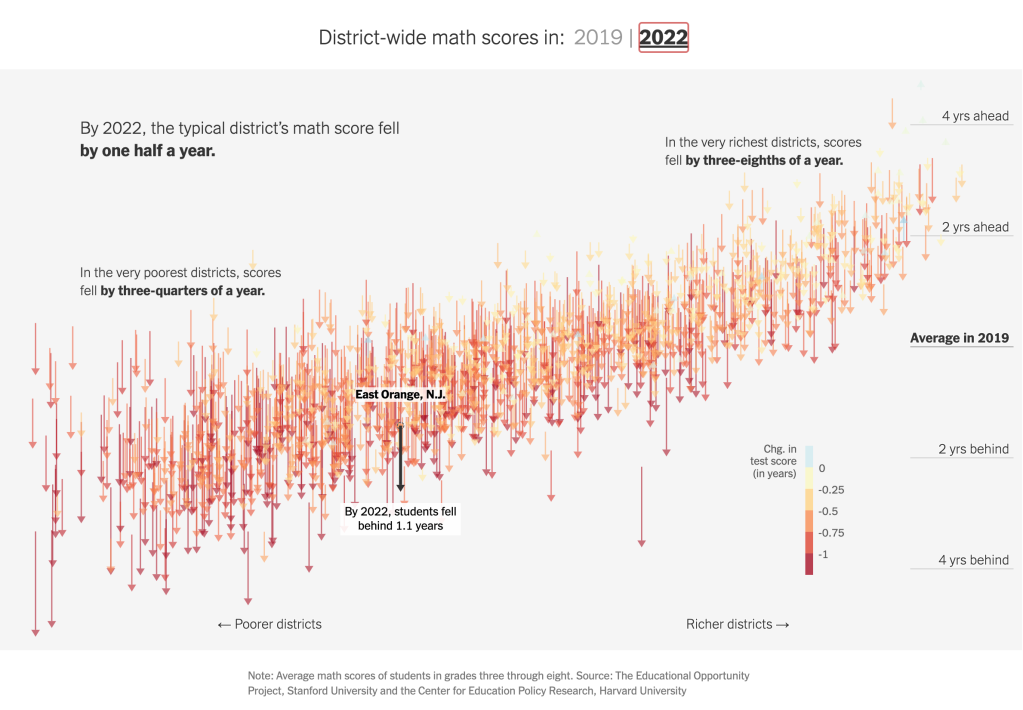
- Getting to SDG4: Useful 2023 UIS report on ‘Trends in learning proficiency in the last 20 years: How close are we to reliable regional and global SDG 4.1.1 trend statistics. Martin Gustafsson’s reports are always great and this is no exception. Sober, evidence-based and useful.
- EGRA outcomes by gender: Nice new report (May 2023) by Fonseca et al out of RTI on “Girls have academic advantages and so do boys: A multi-country analysis of gender differences in early grade reading and mathematics outcomes.
- The Latin-americanisation of SA schools: Last month Johnny Steinberg wrote an interesting op-ed for the Business Day ‘Bad education follows on the township exit of the middle classes. He makes the argument that because the middle classes have left public schools in South Africa, and that “public goods crumble when the middle classes exit”, SA no-fee schools will not improve. It’s an interesting argument and has been made before by Luis Crouch around the transition. I often use an extract of an email exchange I had with Luis in 2018 with my students to explain the nuances and trade-offs faced by the ANC around 1994 (see here). I was asking Luis to contextualise his use of the term “the threat of Latin-Americanisation of SA schools” and he explained it as “The notion that not having the middle classes vocally and publicly support public education as a matter of personal rather than abstract interest, because their own children were in private schools, and that this was deleterious to both accountability and budgetarily support, was fairly commonly held in Latin America at the time. Thus the “Latin-Americanization” notion, a term I may have coined in the South African context.” In most senses this did ‘work’ – SA has a relatively small private school sector. The DBE’s 2022 School Realities shows that only 5,5% of children in South Africa attend private schools (what we call ‘Independent Schools’). That figure is around 17% for most Low and Middle Income countries. Yet that hides the fact that fee-charging public schools are in a way semi-private (they allow parents to top-up public funds with private contributions). See Motala & Carel (2019) I don’t think Johnny’s argument is as clean or simple as he makes it out to be. For example, countries with similar levels of inequality – Brazil / Chile – have much better learning outcomes. It also doesn’t explain why, pre-pandemic, learning outcomes were actually improving quite rapidly (see Van der Berg & Gustafsson, 2019). Personally I think the political economy and bureaucracy dynamics (ANC-SADTU) explain more of the lock-jam than he gives credit to. But great to read thoughtful pieces in our media.
- The Right to Read: The US Right to Read 2023 Trailer – Glad to see campaigns like this getting momentum. Our own Right to Read & Write published by the South African Human Rights Commission (SAHRC) makes similar arguments – essentially that learning to read is a fundamental human right that all are entitled to by virtue of their birth and common humanity.
- Chile’s COVID-19 catch-up program: Tutorías 2023 with a great promo video:
- WCED’s Back on Track Program: On Thursday the WCED launched it’s R1,2-billion ‘Back on Track‘ program covering tutoring, Saturday classes, holiday camps etc. There is some detail in the presentation but we’ll have to wait for the full roll-out plan with all the details. Very encouraging to see a costed and budgeted plan for COVID catch up that matches the scale of the devastation.
- Private schools & PPPs in LMIC: Crawfurd, Hares and Todd (2023) published their paper “The Impact of Private Schools, School Chains and PPPs in Developing Countries” – they conclude that: “The search resulted in over 100 studies on low-cost private schools and PPPs, with a large majority being on low-cost private schools. Our meta-analysis shows moderately strong effects from private schooling, although the limited number of experimental studies find much smaller effects than quasi-experimental studies. This advantage, though, is not nearly enough to help most children reach important learning goals. Turning to policy goals, we find that the private school advantage has not translated to public private partnerships, which have shown limited value in improving quality. They can however represent a lower-cost means of increasing access to school. We also find that private school chains perform little better than individual private schools and have little scope for achieving meaningful scale.”
- Tracking FLN donor spending: SEEK Development launched their “Donor Tracker for Foundational Literacy and Numeracy (FLN)” The dominance of the United States when it comes to bilateral funding for FLN is significant. Of the $505million spent on FLN in 2020, 68% ($344mil) came from the United States (see below). If you do a deep-dive into US funding specifically you see that the total funding for FLN declined sharply between 2019 ($434mil) and 2020 ($344mil), a 21% decline i na single year. FLN funding is also now a smaller proportion of total funding in 2020 (27% of total) compared to 2019 (30% of total). These are worrying trends since it suggests that the biggest bilateral donor is shifting away from FLN. Great tool to look at funding trends over time.

- RISE’s Education Systems Course: The folks at Rise have created an Open Access “Education Systems Course” with lectures and videos. Useful syllabus to catch up on readings in this area.
- School feeding in SA: Given the recent furore over the DBE school feeding scheme (NSNP) failures in the Eastern Cape and KwaZulu-Natal, I was reminded of a 2016 report I came across evaluating the NSNP in two districts in the Eastern Cape. Frustrating that even “stock standard” decades long interventions like the NSNP can go pear shaped without proper monitoring.
- Racial dynamics in SA: Justine Burns and co-authors published a paper in the AER on “Interaction, Stereotypes, and Performance: Evidence from South Africa.” Fascinating paper: “We exploit a policy designed to randomly allocate roommates in a large South African university to investigate whether interracial interaction affects stereotypes, attitudes and performance. Using implicit association tests, we find that living with a roommate of a different race reduces White students’ negative stereotypes towards Black students and increases interracial friendships. Interaction also affects academic outcomes: Black students improve their GPA, pass more exams and have lower dropout rates. This effect is not driven by roommate’s ability.”
- A Moral Education: Garth Greenwell writes an essay for the Yale Review that is at times piercing and other times rambling on “In praise of filth.” I liked the initial discussion about the modern turn (or return) to moralising art and the problems with woke culture categorising art “Within the small world of people who care about literature and art, the culture is as moralistic as it has ever been in my lifetime: witness our polemics about who has the right to what subject matter, our conviction that art has a duty to right representational wrongs, that poems or novels or films can be guilty of a violence that seems ever less metaphorical against an audience construed as ever more vulnerable. We have a sense that the most important questions we can ask about a work of art are whether and to what extent it furthers extra-artistic aims, to what extent it serves a world outside itself. The idea that artists should make what they feel compelled to make, regardless of such considerations, that in fact art should be protected from responsibilities of this kind, seems part and parcel of a discredited Romantic model of the artist as exempt from workaday morality, licensed by genius to act badly, or at least to disregard the claims of others.”
- Learning losses and resisting “back to normal” policies: The New York Times published an article “Parents Don’t Understand How Far Behind Their Kids Are in School” (via Brahm Fleisch). Their conclusion is especially apt in South Africa where the modus operandi has been very much “back to normal” in most provinces: “As enticing as it might be to get back to normal, doing so will just leave in place the devastating increase in inequality caused by the pandemic. In many communities, students lost months of learning time. Justice demands that we replace it. We must find creative ways to add new learning opportunities in the summer, after school, on weekends or during a 13th year of school. If we fail to replace what our children lost, we — not the coronavirus — will be responsible for the most inequitable and longest-lasting legacy of the pandemic. But if we succeed, that broader and more responsive system of learning can be our gift to America’s schoolchildren.”



